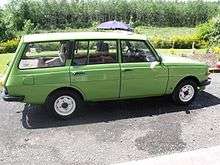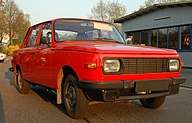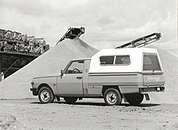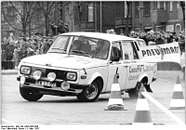Wartburg 353
The Wartburg 353, known in some export markets as the Wartburg Knight, is a medium-sized family car, produced by the East German car manufacturer AWE for their Wartburg brand. It was the successor of the Wartburg 311, and was itself succeeded by the Wartburg 1.3.
| Wartburg 353 | |
|---|---|
1986 Wartburg 353W | |
| Overview | |
| Manufacturer | VEB Automobilwerk Eisenach (AWE) |
| Also called | Wartburg Knight |
| Production | 1966–1988 |
| Assembly | Eisenach, East Germany |
| Designer | Hans Fleischer, in cooperation with Clauss Dietel and Lutz Rudolph |
| Body and chassis | |
| Body style | 4-door saloon 5-door estate 2-door coupe utility (pickup) |
| Layout | FF layout |
| Powertrain | |
| Engine | 993 cc two-stroke I3[1] |
| Transmission | 4-speed manual[1] |
| Dimensions | |
| Wheelbase | 2,450 mm (96.5 in)[1] |
| Length | 4,220 mm (166.1 in)[1] |
| Width | 1,640 mm (64.6 in)[1] |
| Height | 1,490 mm (58.7 in)[1] |
| Curb weight | 920 kg (2,028 lb)[1] |
| Chronology | |
| Predecessor | Wartburg 311 |
| Successor | Wartburg 1.3 |
The Wartburg 353 was produced from 1966 to 1988, becoming the Wartburg with the longest production run. During its lifetime it saw several changes and improvements, the most recognizable of these coming in 1985 with a front facelift (as pictured here), slightly different layout around the engine block and a new carburettor.
The Wartburg 353 was the creation of the former German BMW production facilities (called EMW under Soviet occupation). It was developed from a 1938 DKW design, and powered by an engine with only seven major moving parts, crankshaft included. This led to a common aphorism among Wartburg owners that "one simply drives a car, but must only maintain a motorcycle".
Domestically, it was used for all types of government transportation, sometimes as a police car. However, due to the nature of the planned economy, deliveries to private owners could take ten to fifteen years.
Like other Eastern European cars, it was known for its low price. Because of its forward centre of gravity and front-wheel drive, the car had typical front-wheel-drive road handling, usually displaying significant understeer, especially in wet conditions.
Wartburgs were exported to most European markets and South Africa.
Engine and transmission

The Wartburg 353 was powered by a 1-litre displacement, 3-cylinder unit that took almost two decades to refine. While developing about 50 to 55 PS (37 to 40 kW) (depending on the carburetor type) its two-stroke engine design provided more than 100 N⋅m of torque (106 N⋅m in the last version), which was a typical figure for many larger four-stroke engines at that time. The transmission was equipped with a freewheel, obviating the need to use the clutch between gears. The gear stick was on the steering column. Designed as a fuel efficiency measure and as means of protecting the engine from oil starvation due to the nature of 2-strokes, the device disabled engine braking; the car was able to coast whenever the throttle was released. Drivers had the option of turning the freewheel off through a switch under the steering column to benefit from engine braking. Useful since the front brakes were prone to overheating and fading. However, most drivers never disabled the freewheel, because it made shifting gears significantly easier and smoother, though not quicker.
Today the 353s are customized for reaching speeds well about 200 km/h (125 mph), whereas the original design called for critical speed of 150–155 km/h and 12 seconds to accelerate to 100 km/h (62 mph), which was dealt with in second gear due to the high-rev engine. It was available both with four- and five-speed transmissions, although the latter was very rare.
Popularity
The 353 was a reasonable success throughout the Eastern bloc, with front-wheel drive. The negatives were all due to its outmoded two-stroke engine. In Western European markets the outdated Wartburg was less competitive, especially as the two-stroke engine design gradually stopped being used in passenger cars. The quality and reliability were both problematic; while the low price militated against owners taking care of the car. Resale values were exceedingly low and in Finland, official numbers on removals from the automobile registry gave Wartburg the shortest average life span of any maker listed, at nine years and three months.[2]
The Wartburg 353 was commonly nicknamed "Trustworthy Hans" or "Farty Hans" by owners due to its durability and copious exhaust emissions, especially when cold and/or overoiled. Noteworthy characteristics of the model are: simple design, dependability, occasional and cheap maintenance, strong chassis-based car frame, front-wheel drive, rear wheel ABS regulator, a 525-litre trunk, innovative electronic gauges fitted after 1983. Disadvantages in terms of passengers' comfort are well known too: lack of any sound dampers led to significant engine feedback in the coupe which itself was in turn very boomy and reverberating, leading to another nickname, "The barrel". This left very few Wartburgs equipped with stereo because it was not possible to enjoy that at volumes most people do, over the engine noise. Suspension provided for sensibly different handling and comfort when the car was empty over when it was carrying passengers and luggage. Owners' accounts are that both control and smoothness went better the more the car was loaded.
It was also available as a pickup version named Wartburg 353 Trans, but was not very successful, mainly due to limited payload (only 450 kg) and low volume of transport. It was mainly used for small deliveries. This car was only sold in export, as it would have been useful mostly to the kinds of private business endeavors that were illegal in East Germany.
Wartburg owners' clubs exist throughout Europe and some Wartburgs are still used as rally racing cars.
Production
Over a million Wartburg 353s were produced overall. Production figures (1966–1988):
- 1966–1975 Wartburg 353, 356,330
- 1975–1988 Wartburg 353 W, 868,860
Model development
The transition model Wartburg 312 with the body of the Wartburg 311 and the frame of the later Wartburg 353 was on September 1, 1965. the VIN introduced 65,533. From June 1, 1966, vehicles from VIN 1:30 001 received the new body, associated with a change in the type designation of "1000" to "353". A new transmission received since July 1, 1966 all vehicles from chassis number 001 02:14. The car entered the British market as the Wartburg Knight in early 1967, and a year later the estate "Tourist" model followed.
The introduction of the hatchback Wartburg Tourist with the VEB Karosseriewerke Halle (Saale) made body was carried in 1968. tailgate and rear fenders were made of glass fiber reinforced plastic manufactured. First, the Tourist was manufactured with a smooth C-pillar, in 1970 a forced ventilation system with air outlets in the C-pillar was introduced.
From chassis number 04.10 474, on 6 May 1969, the new Type 353-1 engine with 36.8 kW (50 PS) was introduced. In 1970 ( exactly in 18-th June 1969- according to Mr. Horst Ihling's publication "Wartburg - Help Yourself" ) round instruments replaced the earlier "bathroom scale" type, and in 1972 bucket seats replaced the earlier types.[3] Also in 1972, an optional floor shifter was introduced, but it did not function very well and saw limited sales.[3] and Since 3 March 3, 1975 (from chassis number 10.06 948) the vehicle became the Wartburg 353 W. First shown in 1974, the 353 W received front disc brakes (of Czech manufacture) and many other safety changes such as rollbelts, a collapsible steering column, and dual circuit hydraulic brakes.[3] The body remained unchanged.
From chassis number 17:20 932, on vehicles produced after 14 June 1982, the carburetor was switched to a Jikov 32 Sedr with pre-heated intake mixture (upgrading older models was not suggested), new brake drums rear and H4 headlights.
From 2 January 1984 the "S" version replaced the "de luxe," produced from chassis number 19:00 401. The model was characterized by matt black PVC door window frames, imitation leather trim and wood grain, trunk liner, fog lights (front and rear), two-tone horn, heated rear window and a Malimo corduroy interior. In addition, all models which until then had chromed body parts received black plastic powder coated ones. This was both a sign of shortage of raw materials in the East German economy and an attempt to keep up with the prevailing tastes.
As with the DKW, Wartburgs all had the radiator mounted behind the engine. This changed as of 30 June, 1985 (from chassis number 20:24 100) as the radiator was moved to the usual position in front of the engine. The front clip was also redesigned and was now a one-piece body-coloured unit incorporating the grille opening. The previous bulged rectangle-shaped headlights were replaced with rectangular, slightly swept back units.
Replacements
The Wartburg engineers developed several four-stroke versions, none of which were accepted for series production. In 1972 a four-stroke inline-four of 1.6 litres producing 82 PS (60 kW) was developed, but the political leadership cancelled the project in favor of a facelift. A slack in demand abroad was compensated for by rising demand within East Germany, made possible by wage increases.[4]
In the mid-seventies, a joint project with Škoda and Trabant, led to the development of a Czech-engined design called the 610M. The plug was pulled on this project as the oil crisis had made it impossible to invest in the new plants that would be required.[5] In 1978 the Wartburg 1300 (355), equipped with a Renault engine, was designed.[3] Only four were built, with three-dour coupé bodywork. In the early eighties, as two-strokes were becoming harder and harder to sell, the technical team developed a four-stroke version of the 993 cc three-cylinder unit. In spite of good performance in tests, this too remained stillborn.[3] It wasn't until 1984, when the license for producing Volkswagen's 1272 cc inline-four was gained that Wartburg had their chance. Deliveries of the Wartburg 1.3 finally begun in October 1988, much too late to help AWE survive the reunification.[6]
 Renault-engined Wartburg 355 Coupé (1978)
Renault-engined Wartburg 355 Coupé (1978)- Wartburg 610M (1977)
Competition
The 353 was campaigned extensively, mostly as a rally car. For instance, a 353 driven by Niebergall and Froman finished tenth overall in the 1976 Acropolis Rally.[7] Its best world championship rallying result was a second place in the 1973 Polish Rally, three hours behind the winner. Only one more car reached the finish. The 353's last World Rally Championship result was at the 1993 1000 Lakes Rally, where Alpo Saastamoinen finished 53rd overall and fifth in class (A/5).[8]
Model range
- Sedan, four-door
- Kombi, five-door ("Tourist") (Estate/Station wagon)
- Pickup, two-door ("Trans") (coupe utility)
- Prototypes / Special vehicles
- Wartburg 355 (Renault-engined prototype)
- Wartburg with gas turbines -drive
- Wartburg Rallye Trans (2 built)
- Wartburg 353 Rally Duo, one twin-engined prototype
- Wartburg 353 WR, Group B rally car
- Wartburg 353 W460, rally car
- CMEA car 610 M, developed together with Škoda
- Wartburg 360 (similar to the Audi 80 in appearance)
- Wartburg 400 (Kubel, Wartburg for NVA )
- Wartburg 760 (nicknamed the "pot-bellied pig", this was a projected collaboration with Škoda meant to replace the 353 as well as the Trabant and the Škoda 100)
Special editions
Ambulance
MED-ambulance emergency vehicle of the Red Cross of the GDR in the field of rapid medical aid (SMH), the urgent medical aid (DMH) and the urgent house call service (DHD) with a total of 100 vehicles, of which four were in the service of the National People's Army (NVA)
Melkus
Melkus RS1000 a sports car from Melkus developed from the Wartburg 353.
Gallery
- Early Wartburg 353 with chrome grille and bumper
 later model with black radiator grill and bumper
later model with black radiator grill and bumper.jpg) Wartburg 353 W sedan, post-1985 facelift model
Wartburg 353 W sedan, post-1985 facelift model 353-400 Trans pickup model, for export only
353-400 Trans pickup model, for export only Wartburg 400 prototype for military use
Wartburg 400 prototype for military use Rally version
Rally version
Specifications: Wartburg 353 [9]
- L / W / H: Limousine: 4,220 / 1,640 / 1,495 mm; Tourist: 4,380 / 1,640 / 1,495 mm; Wheelbase: 2450 mm
- Engine: two-stroke three-cylinder gasoline engine liquid cooled,
- Displacement: 992 cm³
- Performance: 37 (until 1986) / 42 kW / 50 (until 1986) / 55 hp
- Torque: 100 (to 1986) / 106 Nm at 3000 / min
- Fuel: Two-stroke mixture 1:50 min 88 RON
- Carburetor: downdraft carburetor BVF-40, from 1982 carburetor Jikov 32 Sedr
- Transmission: four-speed gear train / one reverse gear fully synchronized,
- Freewheel in all gears, manually blockable
- Clutch: single-plate dry clutch with torsion type: T 10-12K
- Chassis: Independent suspension, front driven wheels 13 "tires 165 SR-13, 175/70 R13 or 185-SR 13
- Turning circle: 10.2 m
- Brakes: lockable handbrake, Simplex rear drum brakes, disc brakes front
- Accumulator: 12 V / 38 Ah (from 1981)
- Ignition: breakers, each cylinder an ignition coil; electronic ignition retrofit
- Wiring: DC Alternator 12 V / 220 W, from 1975 alternator 12 V / 588 W
- Head Lights: 1978 H4 halogen headlights 60/55 W
- Boot: 525 litres (sedan); L / B / H 1940/1300/860 mm (Tourist)
- Total mass of empty / payload / total load: Limousine 920 kg / 400 kg / 1320 kg; Tourist: 970 kg / 440 kg / 1410 kg
Specifications: Wartburg 353 WR
- Three-cylinder two-stroke engine with 115 hp (86 kW) at 5500 / min and a torque of 152 N⋅m (112 lb⋅ft) at 4200 / min, engine capacity 1147 cc, three BVF flat current motorcycle racing carburetor, three modified Trabant air filter, power-optimized exhaust system depending on the application range, top speed 188 km / h, 1:40 mixture of modified 62-liter tank
- Five-speed transmission with lockable freewheel
- reinforced closed box section frame, tuned coil springs with gas pressure shock absorbers, internally ventilated disc brakes, rear drum brakes, 6J13-cast magnesium wheels with 185/60 R13 tires
- Length 4,220 mm (166.1 in), width 1,642 mm (64.6 in), height 1,465 mm (57.7 in), empty weight 815 kg (1,797 lb)
- Body parts, GFP fenders front and rear, GFP bumpers, GFP-bucket seats
- Safety roll cage, removable auxiliary lights, tachometer, sports belts
In popular culture
Serbian punk rock band Atheist Rap dedicated a song to Wartburg 353 on their debut album 'Maori i Crni Gonzales' from 1993, titled 'Wartburg Limuzina' ("Wartborg Limousine"), which reflects on the car's characteristics in a humorous but positive way. The song spawned a sequel on their second album 'Ja Eventualno Bih Ako Njega Eliminišete' from 1996, titled 'Car Core', about tuning a Wartburg, also in a humorous way. Both songs were made into music videos and remain among their greatest hits to this day.
See also
- Nissan Rasheen a very small and short 4WD that is often compared to Eastern European cars in design, particularly the Wartburg 353,
References
- "Technical specifications of 1967 Wartburg 353 W". carfolio.com. Retrieved 2008-03-03.
- Merilinna, Martti (1985-03-19). "Joukosta poistuneet" [Leaving the crowd]. Tekniikan Maailma (in Finnish). Vol. 41 no. 5/85. Helsinki: TM-Julkaisu. p. Automaailma 44. ISSN 0355-4287.
- Stünkel, Udo (2000), Bewegte Zeiten: Typenkunde DDR Fahrzeuge, Personen- und Lieferwagen [Moving times: model identifier for East German vehicles, passenger and delivery vehicles], Bremen, Germany: Verlag Peter Kurze, p. 38, ISBN 3-9806977-9-7
- "VEB Automobilwerk Eisenach" (in German). motorostalgie. Archived from the original on 2017-08-16.
- Ihling, Horst (November 1994). "Verschlußsachen" [Classified information]. Oldtimer Markt (in German).
- Stünkel, p. 39
- Thevenet, Jean-Paul, ed. (January 1977). "Une Ford quand même!" [A Ford in the end!]. L'Automobile (in French). Neuilly, France: Societé des Editions Techniques et Touristiques de France (367): 71.
- "AWE Wartburg 353 WR group 2 (1977)". Racing cars and their history. Retrieved 2015-11-14.
- Kraftfahrzeug Technik, Heft 7/66 http://www.die-besten.de/wartburg/tests/353/353-66/353-66.htm
| Wikimedia Commons has media related to Wartburg 353. |